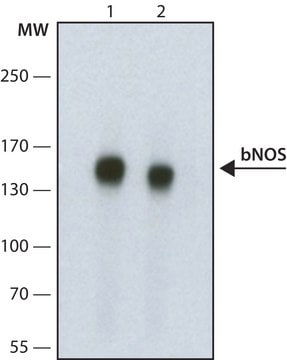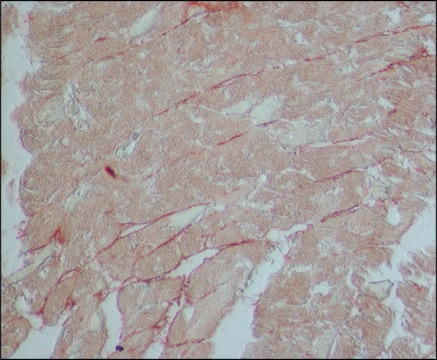N9657
Monoclonal Anti-Nitric Oxide Synthase, Inducible antibody produced in mouse
clone NOS-IN, ascites fluid
Sinónimos:
Anti-iNOS
About This Item
Productos recomendados
biological source
mouse
Quality Level
conjugate
unconjugated
antibody form
ascites fluid
antibody product type
primary antibodies
clone
NOS-IN, monoclonal
mol wt
antigen 130 kDa
contains
15 mM sodium azide
species reactivity
mouse, rat
packaging
antibody small pack of 25 μL
technique(s)
microarray: suitable
western blot: 1:1,000 using whole cell extract of the murine macrophage cell line RAW 264.7 activated with LPS and IFN-γ
isotype
IgG1
UniProt accession no.
shipped in
dry ice
storage temp.
−20°C
target post-translational modification
unmodified
Gene Information
human ... NOS2(4843)
mouse ... Nos2(18126)
rat ... Nos2(24599)
Categorías relacionadas
General description
Specificity
Immunogen
Application
- immunofluorescence staining
- immunogold electron microscopy
- immunoblotting
- immunohistochemistry
- immunocytochemistry
- enzyme linked immunosorbent assay (ELISA)
Biochem/physiol Actions
Disclaimer
Not finding the right product?
Try our Herramienta de selección de productos.
Storage Class
12 - Non Combustible Liquids
wgk_germany
WGK 3
flash_point_f
Not applicable
flash_point_c
Not applicable
Certificados de análisis (COA)
Busque Certificados de análisis (COA) introduciendo el número de lote del producto. Los números de lote se encuentran en la etiqueta del producto después de las palabras «Lot» o «Batch»
¿Ya tiene este producto?
Encuentre la documentación para los productos que ha comprado recientemente en la Biblioteca de documentos.
Nuestro equipo de científicos tiene experiencia en todas las áreas de investigación: Ciencias de la vida, Ciencia de los materiales, Síntesis química, Cromatografía, Analítica y muchas otras.
Póngase en contacto con el Servicio técnico








